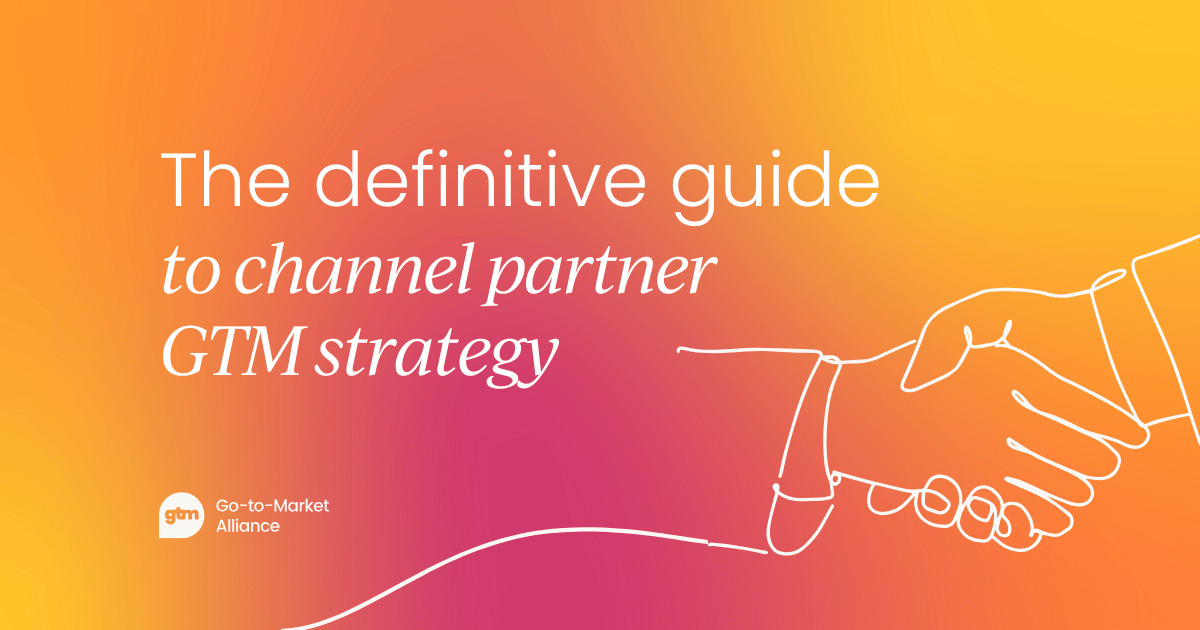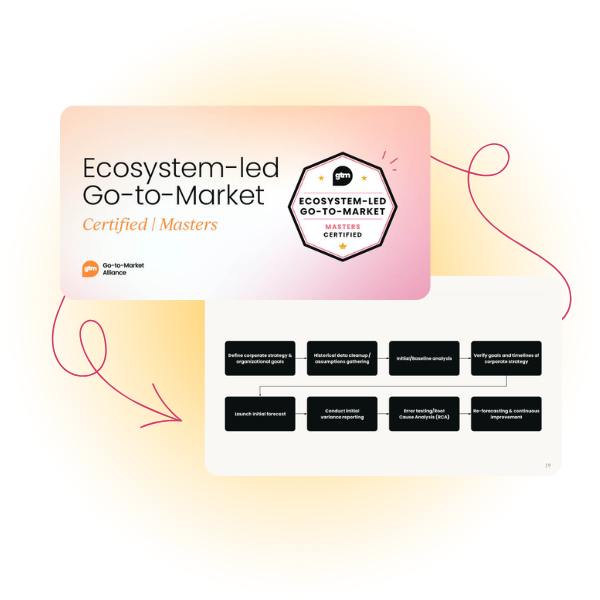Implementing partnerships into your GTM strategy is increasing in popularity, but how impactful is it really?
This article explores the impact of partnerships on go-to-market success, and how to implement best practices to make the most of your network-led GTM motion.
We also include advice from GTM pros who’ve been there, and done that, when it comes to working with partners.
Defining partnerships
We define a partnership as “an interconnected network of businesses, communities, and individuals that work together and often rely on each other to offer end-to-end value to their shared customers or prospects.”
In his book, ‘Ecosystem-led growth’, Bob Moore explains that your partnerships are more of an interconnected network than a central hub (wherein all interactions are clearly marked and directional).
Your network is meant to be more adaptable and agile, with multiple companies influencing each other indirectly.
This simply means that the range of your network goes beyond just the companies you directly interact with and that you’re one “connection away from any new partner.”

For more information on partnership GTM, check out this article:

Types of GTM partnerships
There are many different types of partnerships available to GTM pros, all with their own unique benefits and use cases. Let’s explore a few common partnership types.
Tech partnerships
This type of partnership involves tech product integrations between multiple companies to make their unique offerings interoperable or complementary.
Essentially, “once the integration is activated by the end user, the products have made each other more deeply entrenched in the user’s experience.” Suddenly you can’t have one without the other; you’d experience either product very differently.
Example: an audio streaming provider played across different devices so users can stream podcasts, audiobooks, and music wherever they are.
Channel partnerships
Your channel partners are basically any company or third-party that helps to market, sell, and distribute your product. These partnerships help your company reach new markets and customers by leveraging your partner’s market presence.
These third-parties can be:
- Vendors,
- Resellers,
- Affiliate businesses,
- Distributors.

Strategic partnerships
This isn’t necessarily a specific kind of business partnership, per se. Instead, it refers to any partnership that aims to achieve long-term benefits for all parties involved.
These partnerships often involve joint ventures, shared research, and co-marketing initiatives, all of which help sustain the network’s commitment to each other and their collective goals.
Marketplaces
Finally, we’ve got marketplaces.
This word means exactly what you think: a place where you go to purchase goods. Nowadays, your marketplace can be an online platform where your vendors sell or showcase your products.
They’re great if you want to reach a range of buyers. And marketplaces are considered an ecosystem because, well, these are shared platforms where many different companies indirectly collaborate.

Benefits of partnerships
To really get a sense of the impact a partner ecosystem has, we asked our contributor, Ankita Asthana, Principal Consultant of Product Marketing at LTIMindtree, to share some ways in which her tech partners helped her overall GTM strategy.
“Strategic partnerships work because they leverage the strengths of multiple players to create a more compelling offering, reach a wider audience, and achieve shared success.
“Similarly, by combining complementary strengths (which brings synergy), your partnerships expand reach and touchpoints for a win-win scenario, double savings through shared resources, and foster innovation via cross-pollination of ideas.
“When it comes to elevating your product's go-to-market strategy, strategic partnerships offer a multitude of benefits. In addition to the expanded reach and collaboration opportunities, it also helps align sales and marketing teams of both organizations to plan targeted and personalized campaigns that are a win-win for everyone.
“The catch here is to understand how the joint value prop fits into what the customer is looking for and communicate the same to the target audience.
“In my last role as an assistant marketing manager, I was experimenting with how to plan joint GTM campaigns with our tech partners.
“We made it a point to focus on what our complimentary strengths were and how it fits into the broader customer problem. This helped us both at strategic and operational levels.
“We launched a thought leadership campaign to call out how the two can work 'better together', and the final solution we created with the partner not only helped reduce the tech burden of the customer (with reduced integration hassles), it also helped in giving the best price with product bundling.
“The approach is still working with new customers from the partner's side willing to have more in-depth conversations with us.

Best practices for success
Ankita also shared her best practices for working smoothly with your partner to ensure a successful go-to-market plan.
Selecting partners
“You need to choose partners whose offerings complement yours and whose target audience aligns with your own. Focus on building win-win relationships where both sides benefit from the partnership.
“Our core proposition on simplifying AI on cloud data was complementary to our cloud partner’s mission of democratizing data and AI for all enterprises.
“This meant all our content and communication was aligned from the word ‘go’ and made it easier to plan our joint GTM and content strategy calendar from the start.”
Define your shared value proposition
“Clearly define the value proposition of the combined offering. How does the partnership create a better solution for your customers than either offering alone?
“Again, having a clear joint value proposition made it easier to create supporting assets around the topic and even helped create a comparative report on ‘one vs together’ which showed clear quantitative benefits of purchasing the products together.”

Consider your users
“User experience should not go for a toss when working on joint solutions with partners. Partners should work together to ensure their products integrate smoothly and data flows easily between them.
“Our AI and tech team worked together with the cloud partner team to create
solution that married both the capabilities seamlessly and the tech
documentation was also done together so the onboarding was simplified for
all customers.”
Align sales and marketing
“Both the partners need to be in sync on their sales and marketing efforts to push and effectively communicate the joint value proposition.
“Additional, joint campaigns like co-branded events, roadshows, joint webinars, or even co-selling opportunities need to be explored to make it successful.
“Our joint GTM calendar comprised thought leadership articles, comparative
whitepaper, articles, blogs, technical povs as well as webinars to promote and build a healthy leads pipeline.”
Measuring success
“Clear metrics need to be established in advance with partners to measure the success of the joint initiatives. This could include metrics like customer acquisition cost, lead generation, or sales conversion rates.
“We measured the program success on metrics such as social engagement on our posts, number of downloads of joint assets, cost per lead by paid campaigns, and number of meetings enabled with sales teams from both the companies.”

Potential pitfalls or complications
As with anything in life, nothing good comes without its complications.
From data sharing concerns to uncertainty surrounding adequate privacy information management, there might be some initial drawbacks to adopting an ecosystem-led function.
However, there are always areas for improvement if you’re an ecosystem-led growth platform. And, when looking for appropriate partners, make sure they uphold the highest standards or have privacy certifications in place, for example.
Here’s what our contributor, Asher Mathew, CEO at Partnership Leaders, thinks of potential roadblocks when finding partners and ways to work around them.
Doing more with less
“You've probably heard "do more with less" all year long. But I would encourage you to take this a step further when looking at your partnerships, because you need to do more for less with your partners.
“It’s clear that partners impact the entire customer journey.
“One would argue that leads start the pre-sales process and implementation or managed services complete the post-sales process. So partners are now able to have an impact throughout the customer journey.
“When we looked at the data a little bit more closely, we found that the impact partners have on buyers is second only to word of mouth.
“And you'll see that the two highest ranking factors when making a purchase decision are the opinions of those in their professional networks, and trusted agencies, consultancies, and tech vendors.
“So as the company grows, partners become more important to the marketing mix.
“Then the question really becomes, why aren't partnerships doing more revenue?
“And there's a healthy amount of people who think that partners can help anywhere between 1 to 25%, in terms of the percentage of new logo leads and a source for the company.
“Why can't they do more? What's stopping them from doing more?
“When companies run co-marketing campaigns, they see about the same amount of uplift or improvement in customer acquisition cost, brand awareness, engagement rates, conversion rates, and quality of leads.
“I think that's because of the planning tax.”

Avoiding the ‘planning tax’
“The planning tax comes into play because two companies have to take their plans and combine them together, which means that there needs to be a framework that helps you go deeper into your relationship with your partners.
“You'll see that other reasons why companies aren't able to go deeper in relationships with their partners, or why they're not where they want to see more improvement, is all around coordination and planning and communication.
“If you want to be an industry-grade organization that’s working with partners (and maybe even an industry-leading organization), then you need to move from ad-hoc partner marketing spend to programmatic partner marketing spend, or ad-hoc partner management to programmatic partner management.
“When you speak with a company and ask them how they came up with their partner list, they can't explain that to you. Or they have a number of manual processes, very little visibility into outcomes, or just limited enablement.
“Those are all symptoms of ad-hoc program management.”
The solution: Becoming programmatic
“What we're recommending is that you go programmatic:
- First, you ask: what does your ideal partner profile look like?
- Then you look at what types of automation are available that enable tracking, and efficient workflows.
- Finally, you follow brand guidelines strictly, focus on outcomes, and provide ongoing enablement and training.
“When all of these things come together, you'll be able to evade the planning tax and have a much better and deeper working relationship with your partners.”

Metrics and benchmarks
In this final section, we’ll look at some of the best KPIs and metrics to measure your ELG motion’s success as well as those collective insights that’ll enable your teams to benefit from your partner data.
Of course, if there are any team-wide metrics you track normally (churn rates, CLV, ARR, you name it) don’t forget those!
However, when looking at performance across your ecosystem, there are partner-specific metrics you should consider.
You’ll want to track the following:
- Number of new leads passed over from that partner
- Number of opportunities that moved to the pipeline from those leads
- Number of deal wins that were converted from those opportunities
- Number of opportunities involving your partner
- Number of deal wins that resulted from this involvement
Forge industry alliances and become unbeatable
Looking for the full, actionable low-down on building partnership strategies?
Sign up to Ecosystem Go-to-Market: Masters and Reach new audiences, amplify your messaging, and finally sell at scale when you learn how to leverage strategic partnerships the right way.














